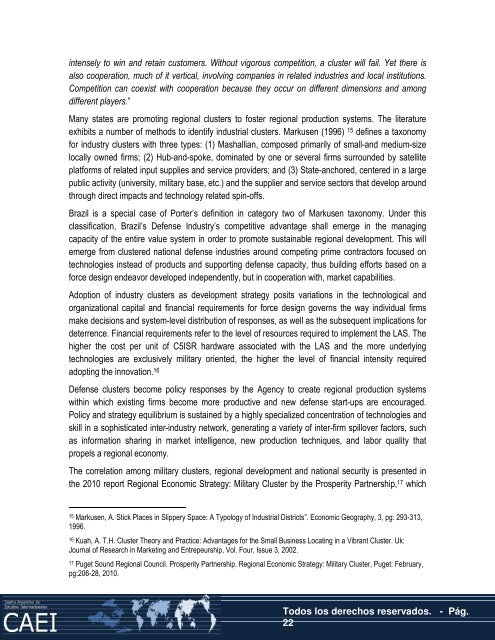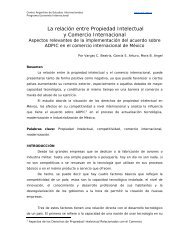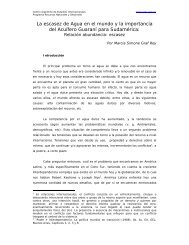Brazil's Defense Industry: The Emerging Transformational ... - CAEI
Brazil's Defense Industry: The Emerging Transformational ... - CAEI
Brazil's Defense Industry: The Emerging Transformational ... - CAEI
You also want an ePaper? Increase the reach of your titles
YUMPU automatically turns print PDFs into web optimized ePapers that Google loves.
intensely to win and retain customers. Without vigorous competition, a cluster will fail. Yet there is<br />
also cooperation, much of it vertical, involving companies in related industries and local institutions.<br />
Competition can coexist with cooperation because they occur on different dimensions and among<br />
different players.”<br />
Many states are promoting regional clusters to foster regional production systems. <strong>The</strong> literature<br />
exhibits a number of methods to identify industrial clusters. Markusen (1996) 15 defines a taxonomy<br />
for industry clusters with three types: (1) Mashallian, composed primarily of small-and medium-size<br />
locally owned firms; (2) Hub-and-spoke, dominated by one or several firms surrounded by satellite<br />
platforms of related input supplies and service providers; and (3) State-anchored, centered in a large<br />
public activity (university, military base, etc.) and the supplier and service sectors that develop around<br />
through direct impacts and technology related spin-offs.<br />
Brazil is a special case of Porter’s definition in category two of Markusen taxonomy. Under this<br />
classification, Brazil’s <strong>Defense</strong> <strong>Industry</strong>’s competitive advantage shall emerge in the managing<br />
capacity of the entire value system in order to promote sustainable regional development. This will<br />
emerge from clustered national defense industries around competing prime contractors focused on<br />
technologies instead of products and supporting defense capacity, thus building efforts based on a<br />
force design endeavor developed independently, but in cooperation with, market capabilities.<br />
Adoption of industry clusters as development strategy posits variations in the technological and<br />
organizational capital and financial requirements for force design governs the way individual firms<br />
make decisions and system-level distribution of responses, as well as the subsequent implications for<br />
deterrence. Financial requirements refer to the level of resources required to implement the LAS. <strong>The</strong><br />
higher the cost per unit of C5ISR hardware associated with the LAS and the more underlying<br />
technologies are exclusively military oriented, the higher the level of financial intensity required<br />
adopting the innovation. 16<br />
<strong>Defense</strong> clusters become policy responses by the Agency to create regional production systems<br />
within which existing firms become more productive and new defense start-ups are encouraged.<br />
Policy and strategy equilibrium is sustained by a highly specialized concentration of technologies and<br />
skill in a sophisticated inter-industry network, generating a variety of inter-firm spillover factors, such<br />
as information sharing in market intelligence, new production techniques, and labor quality that<br />
propels a regional economy.<br />
<strong>The</strong> correlation among military clusters, regional development and national security is presented in<br />
the 2010 report Regional Economic Strategy: Military Cluster by the Prosperity Partnership, 17 which<br />
15 Markusen, A. Stick Places in Slippery Space: A Typology of Industrial Districts”. Economic Geography, 3, pg: 293-313,<br />
1996.<br />
16 Kuah, A. T.H. Cluster <strong>The</strong>ory and Practice: Advantages for the Small Business Locating in a Vibrant Cluster. Uk:<br />
Journal of Research in Marketing and Entrepeurship, Vol. Four, Issue 3, 2002.<br />
17 Puget Sound Regional Council. Prosperity Partnership. Regional Economic Strategy: Military Cluster, Puget: February,<br />
pg:206-28, 2010.<br />
22<br />
Todos los derechos reservados. - Pág.<br />
22

















